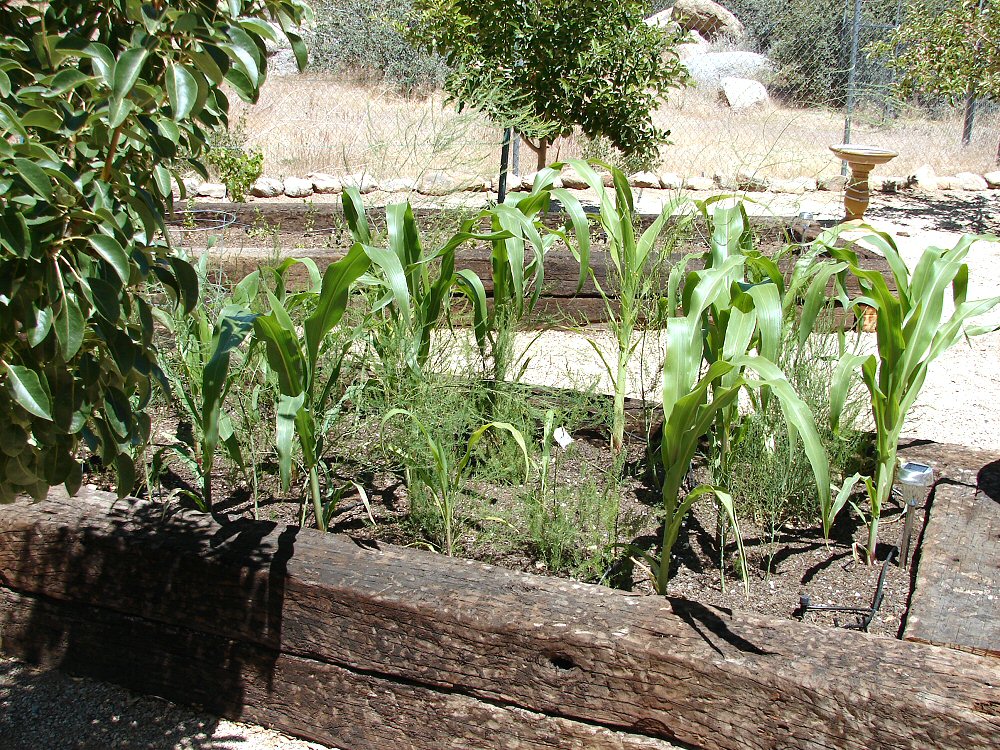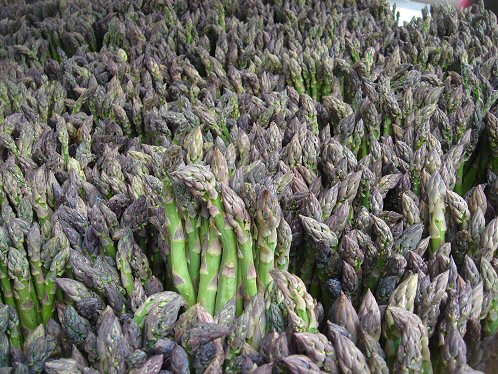Arizona Vegetable & Fruit Gardening
For The Arizona Desert Environment.
Pictures, Photos, Images
Descriptions, Information, & Reviews.
We Are Proud Of Our SafeSurf Rating!
 |
| Asparagus, Asparagus officinalis. - Photo Taken June 10, 2011 In Yarnell, Arizona. Eight Weeks From Planting Three Year Old Crowns. Planted With Peruvian Corn. Jersey Supreme Hybrid Asparagus, & Mary Washington Improved Asparagus. |
|---|
 |  |
| Spears. Asparagus, Asparagus officinalis. Courtesy Wikipedia, the free encyclopedia. | Cladodes. Asparagus, Asparagus officinalis. |
|---|



Asparagus Asparagus plants are not only a delicious vegetable, but different species can also be lovely as houseplants. The Asparagus officinalis is the botanical name of the vegetable garden variety that is eaten. The other asparagus mostly are the greenhouse varieties which come from South Africa. These are perennial plants with erect stems and tiny branches bearing inconspicuous flowers followed by reddish berries that contain black seeds. Asparagus meyeri, Asparagus plumosus, and Asparagus Sprengeri are examples of the non - edible varieties. Asparagus is believed to be native to the east Mediterranean and the Middle East. It thrives along sandy riverbanks, shores of lakes and wet, salty coastal areas. It is very salt tolerant. Today it grows �wild� across many of the areas around the world where it is grown for food. This includes Europe, Russian, and North America. (Boswell, 1949) Asparagus grows into a tall upright bush. Flowers are small, with two yellowish-green rings of petal-like tepals. Most fruit bearing plants bear bisexual flowers or plants (having both male and female reproductive parts), but asparagus is dioecious, having male and female flowers occurring on different plants. Botanists today are using asparagus to learn more about mechanisms of sex determination and the genes that control floral development. Pollen is carried from male plants to female plants by insects. If female flowers are pollinated, they produce bright red berries (See photo), which are dispersed by birds. (Rhodes, 2005; Park, 2004). Records of human use of asparagus date back to the beginning of records. Ancient Egyptian paintings depict cultivation. Early Greek and Roman records detail growing instructions and medicinal uses. Greeks believed the plant could cure everything from toothaches to heart ailments. (California Asparagus Commission, 2005; Trowbridge, 2005; Rangarajan, 2005) The Roman emperors permanently employed people to collect asparagus from the wild and the upper class brought it with them as they conquered new lands (Boswell 1949; Austparagus, 2005). In the 1600s King Louis XIV of France ordered special greenhouses built for asparagus (Stradley, 2004). His lover, Madam de Pompadour, is said to have served asparagus to increase sexual vigor (Austparagus, 2005). Asparagus was reputed to be an aphrodisiac based on the "Law of Similarity", where the shape of an object dictates its properties (Austparagus, 2005). Then Europeans took asparagus worldwide as they settled in new lands. Today Aparagus is valued economically as a food source. It is high in folacin, which as been shown to aid in blood cell formation, growth, and prevention of liver disease and neural tube defects. It is also a recognized diuretic and laxative. (Michigan Asparagus Advisory Board, 2000). It is of major economic importance in Peru. It is one of their major exports to Europe. Asparagus officinalis was once classified in the lily family, like its Allium cousins, onions and garlic, but the Liliaceae have been split and the onion-like plants are now in the family Amaryllidaceae and asparagus in the Asparagaceae. Although a cold-hardy vegetable plant, asparagus spears can be damaged when exposed to temperatures below 33 degrees F. Cover them with a thick cardboard box to protect them overnight from frost. Damaged spears will rot and new spears take four to five days to replace them, according to Iowa State University horticulturists. The emphasis of this article will be upon the type we eat, commonly called the garden variety.
PLANTING-Garden Variety:
If you grow them in beds, a suitable size would be four to five feet and separated by a width of two feet. A bed this size will hold three rows. The outer rows being 9-12 inches from the edge and 18 inches on each side of the center row. It is beneficial to prepare your garden with rich, fertile, well-drained soil, as an asparagus bed can be working for at least twenty years. The ground should be dug up to a depth of 2 feet and if it has a lot of clay, stone or broken bricks should be put in. Partially decayed manure should be mixed in to the lower layer of soil and bone meal at the rate of 3 or 4 ounces per square yard should be mixed into the top layer. Asparagus crowns can also be planted in rows. The rows should be 6 inches deep with the manure and bone meal added as above, and 3 feet apart. The plants should be 18 inches apart. The best time to plant is in early spring. They should be covered with 5 or 6 inches of soil. While the asparagus is out of the ground, the roots need to be kept moist. If one year old roots are planted, the asparagus shouldn�t be cut until the third year, if roots two years old are planted, they shouldn't be cut until the second year. Three year old roots can be cut the following year. The asparagus should be cut just under the ground when they reach a height of about 9 inches. Your asparagus needs to be kept moist during hot, dry weather. The shoots shouldn't be cut after the third week in June. When the leaves, which are really called cladodes, have turned yellow in the fall, the stems need to be cut to the ground. After they have been cut down, you should add compost or manure to the topsoil. In spring, this mixture of fertilizer should be added and mixed into the ground at 3 ounces per square yard: 1 part sulphate of potash and 1 part sulphate of ammonia. NOTE: We strongly recommend using Raised Beds or Asparagus. Asparagus will produce spears for 10 - 20 years. Some are known to have produced as long as 40 years. They also can become 4-6 feet tall at maturity. Therefore, we recommend placing them in the back part of a garden or raised bed. There are several varieties of asparagus to chose from so that can be confusing. We have had the best success in Yarnell, Arizona with; Jersey Supreme Hybrid Asparagus, Mary Washington Improved Asparagus, & Jersey Knight Hybrid Asparagus. We also recommend planting either 2 or 3 year old crowns. That will enable you to make a harvest 1 or 2 years sooner than if you plant younger crowns.
Quick Notes:
Type: Vegetable.
Height: About 7-10 inches tall (edible spears); 4-6 feet tall at maturity.
Spread: About 1-3 feet wide.
Flowers: Small, with two yellowish-green rings of petal-like tepals.
Blooming Time: Spring through Fall.
Leaves: Blue-green to green in color, finely dissected, and soft to the touch. But, asparagus have no functional leaves, those little green things on the stems are really called cladodes..
Hardiness:
Elevation: 0 - 5,500 feet.
Light: Full Sun.
Soil pH requirements:
Habitat: Mulched areas. Prefers well-drained soil with a neutral pH. (Add lime to the soil if it is acidic).
Native: Europe, northern Africa and western Asia, and it is widely cultivated as a vegetable crop. Especially in Peru.
Miscellaneous: Photos Taken June 10, 2010 In Yarnell, Arizona. Hardy Temp: 27�F.
|



|
Here Are Some Links To The Very Best & Most Popular Items Sold On Amazon.Com
|
|---|
| Back To Arizona Vegetable & Fruit Gardening
|
| Back To Arizona Xeriscape Landscaping Main Page
|
| To Arizona Wild Flowers Home Page
|
| Back To DeLange Home Page
Images And Text Copyright Eve & George DeLange.
|


